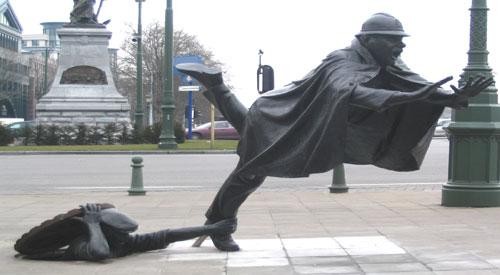Falling (accident)

Introduction
Falling is a major cause of personal injury, especially for the elderly whose vision, nerve conduction and muscles are weaker, whose vestibular sense is diminished, whose neurological responses are extended, whose bones have grown brittle, and who consume medications at an increased rate. Builders and miners represent worker categories representing high rates of fall injuries. The WHO estimate (2002) that 392,000 people die in falls every year. In 1972, Vesna Vulović survived a fall from 33,000ft without a parachute.[1][2][3][4]
Falls in the workplace
Falls from elevation hazards are present at most every jobsite, and many workers are exposed to these hazards daily. As such, falls are an important topic for occupational safety and health services. Any walking/working surface could be a potential fall hazard. An unprotected side or edge which is 6 feet or more above a lower level should be protected from falling by the use of a guardrail system, safety net system, or personal fall arrest system. [5] These hazardous exposures exist in many forms, and can be as seemingly innocuous as changing a light bulb from a step ladder to something as high-risk as connecting bolts on high steel at 200 feet in the air. Falls are the second leading cause of work-related death in the U.S. [6] In 2000, 717 workers died of injuries caused by falls from ladders, scaffolds, buildings, or other elevations.[6]
Falls from buildings
Falls from buildings are often accidental but can also be caused intentionally, such as by defenestration. Injuries resulting in falls from buildings vary depending on the building's height, and also depend on the type of person (infant, child, adult, elderly adult, etc.) Falls from the second floor usually result in injuries, but are not fatal. Companies must make sure that they follow the Occupational Health and Safety Act in order to keep the work environment safe for it's employees, and it happens to each and everyone. Surviving a fall from higher points requires not injuring your head or pelvis.[7]
Elderly
Stephen Lord at the University of New South Wales studied 80,000 elderly persons in Australia and found that the risk of falling increases for any who are taking multiple prescription medications and for all who are taking psychoactive drugs. This increased risk was demonstrated through the use of a variety of balance and reaction time tests. Inexplicably, the older men when matched with women of identical height, weight, and age, on average, performed measurably better in all of the balance and reaction time tests.
Assessing risk of falls
The presence of various medical conditions and the results of functional tests can assess the risk of falling.[8] Examples of such tests are Gait velocity and the Timed-Up-and-Go tests.[9]
A Timed-Up-and-Go test of < 15 seconds suggests a low risk of falling.[10] In the Timed-Up-and-Go test "patients to stand up from a chair, walk a short distance, turn around, return, and sit down again."[11] A Timed-Up-and-Go test (stand=up; walk 10 feet; turn around; walk 10 feet; return to sitting) generally required 10 seconds.[12]
References
- ↑ TV.com - Mythbusters: Escape Slide Parachute (Story of Vesna Vulović)
- ↑ An article on Damn Interesting
- ↑ Interview with Vesna Vulović
- ↑ The New York Times - Serbia’s Most Famous Survivor Fears That Recent History Will Repeat Itself
- ↑ "NIOSH Falls from Elevations". United States National Institute for Occupational Safety and Health. Retrieved 2007-11-04.
- ↑ 6.0 6.1 >"STRATEGIC PRECAUTIONS AGAINST FATAL FALLS ON THE JOB ARE RECOMMENDED BY NIOSH" (Press release). National Institute for Occupatinal Safety and Health. 2001-01-02. Retrieved 2007-11-04.
- ↑ Wenner, Melinda (2008-01-07). "How To Survive a 47-Story Fall: Make sure you land on your feet". Slate.
- ↑ Thurman DJ, Stevens JA, Rao JK (2008). "Practice parameter: Assessing patients in a neurology practice for risk of falls (an evidence-based review): report of the Quality Standards Subcommittee of the American Academy of Neurology". Neurology. 70 (6): 473–9. doi:10.1212/01.wnl.0000299085.18976.20. PMID 18250292.
- ↑ van Iersel MB, Munneke M, Esselink RA, Benraad CE, Olde Rikkert MG (2008). "Gait velocity and the Timed-Up-and-Go test were sensitive to changes in mobility in frail elderly patients". J Clin Epidemiol. 61 (2): 186–91. doi:10.1016/j.jclinepi.2007.04.016. PMID 18177792.
- ↑ Nordin E, Lindelöf N, Rosendahl E, Jensen J, Lundin-Olsson L. Prognostic validity of the Timed Up-and-Go test, a modified Get-Up-and-Go test, staff's global judgement and fall history in evaluating fall risk in residential care facilities. Age Ageing. 2008 Jul;37(4):442-8. Epub 2008 May 30. doi:10.1093/ageing/afn101 PMID 18515291
- ↑ Mathias S, Nayak US, Isaacs B. Balance in elderly patients: the "get-up and go" test. Arch Phys Med Rehabil. 1986 Jun;67(6):387-9. PMID 3487300
- ↑ Bohannon RW (2006). "Reference values for the timed up and go test: a descriptive meta-analysis". J Geriatr Phys Ther. 29 (2): 64–8. PMID 16914068.